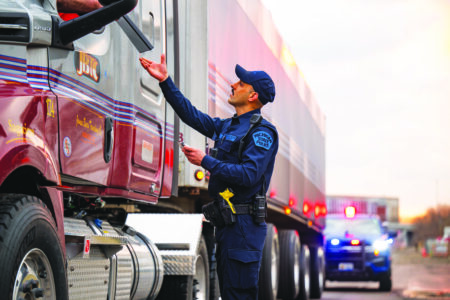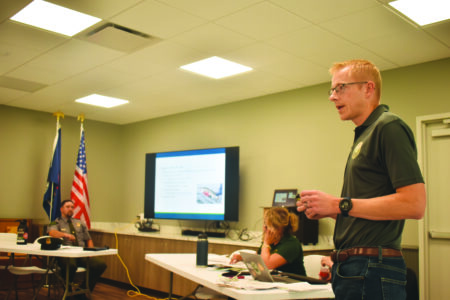Talking about walleye
Proposed size restrictions discussed

Ben Garbacz/Daily Mining Gazette Dave Caroffino gave a presentation before the Western Upper Peninsula Citizens Advisory Council regarding potential walleye regulations in certain lakes throughout the U.P. The goal of the restrictions will allow walleye to spawn at least once before they are harvested.
ONTONAGON — Potential new walleye regulations making walleye from 18 to 23 inches restricted for harvest in certain lakes in the U.P. were discussed at Thursday’s Western Upper Peninsula Citizens Advisory Council meeting. A presentation from Fisheries Biology Specialist for the Michigan DNR Dave Caroffino outlined the declining walleye population across the Upper Midwest and how new regulations can address the issue.
Caroffino said there are a few different factors for the region wide population decline, beginning with more variable environmental conditions. He pointed out there has been less normal springs and winters in recent years.
“They like things to be normal, and we don’t have a lot of normal anymore, so the frequency at which they are successfully reproducing is becoming less and less often, so we’re seeing more sporadic reproduction which has contributed to some of those declines,” Caroffino said.
People have also been moving other fish such as crappie into walleye habitats, which Caroffino said is a horrible thing to do for walleye populations. The increased number of bass have also created more resource conflict for walleye.
The understanding of maintaining a healthy walleye population from harvest numbers has changed. Caroffino explained research conducted in Wisconsin suggested 35 percent of a walleye population can be harvested without too much of an impact, but this is no longer accepted. Caroffino said each population is different and the number probably lies closer to 20 to 25 percent.
When it comes to what can be done about the walleye population, Caroffino said habitat restoration and stocking are valuable, but each comes with a drawback. Habitat work can be difficult and expensive, and stocking does not work everywhere.
“Typically, if you’ve got populations that reproduce on their own, stocked fish don’t do as well because they’re not specifically acclimated to that water body,” he said.
Regulations were discussed at the presentation. Currently, statewide walleye regulations allow anglers to harvest up to five walleye 15 inches or longer with exception to specific bodies of water throughout Michigan. Some of the exceptions include the Ontonagon River and Portage and Torch Lake systems, which allows for only one walleye over 23 inches to be possessed as a daily possession limit.
The new proposed limits would introduce a protected slot limit of which states walleye of a certain size cannot be harvested. Any walleye between 18 and 23 inches would not be harvestable, though the 15 inch size minimum and fish over 23 inches would remain in place.
“The reason for that is that we still want fish to have a chance to spawn at least once before they’re subject to harvest,” Caroffino said. “But because we’re seeing more variable reproduction, we want to protect more of those females. So that’s the 18 to 23 inch window, so they’re in the population longer and have more chances to hopefully experience that normal year where they can reproduce.”
The lakes which are potential candidates for the regulation updates are as follows: Gratiot Lake, Lake Gogebic, Pomeroy Lake, Winslow Lake, Stanley Lake, Lake Mary, Lake Independence, Teal Lake, Big Manistique Lake and Milakokia Lake. The widespread nature of lakes will allow for a diverse study looking into several different types of lakes, and nine of them allow natural reproduction. Preexisting data for these locations also allows to make comparisons with future collected data. Lac La Belle was an example of not being selected due to no preexisting data. However, future locations can be considered once data becomes available.
“It’s really cool that we’re able to get that lake way up in the Keweenaw, because the Keweenaw is so different. We had a public meeting up there last week and we had 98 percent of the people in the room support the regulation, after we talked through kind of what we were doing, why we were doing it,” Caroffino said. Other locations will still need to have local meetings to discuss potential changes and whether the regulations will be considered will depend on feedback.
Caroffino believes the regulations will also assist in the size structure of the populations.
“In populations where there’s a lot of harvest, you don’t see a ton of fish that are that 19, 20, 21, inches, they get harvested. So this will improve the size structure of fish. It’s likely it will also increase the density. We would like to see if this regulation can effectively do that, and then overall, it kind of improved the quality of the fishery. That’s a difficult one, because people have different opinions of what makes a quality fishery,” he said.
The regulations will be proposed to the Natural Resource Commission (NRC) with a 12 year plan. Time will be needed to analyze the growth rate, population and other factors of the overall health of the walleye.
“We need a little bit of time before we can start those so we need the regulation to be in effect right now, our plan is let it go for three years, then start doing our first kind of check in evaluation. It will take us four years to do a population estimate in those 10 lakes based on the crews we have in the UP,” Caroffino said. He explained there are three years off, four years of a first round evaluation and four years of a second round evaluation and then the last year asking the question, “Does this work?”
Caroffino added while the walleye studies are going on, there will be evaluations of habitat and other fish species and how the regulations on walleye effect them. The regulations will go toward the NRC in August with a decision on the matter to be made in October.





